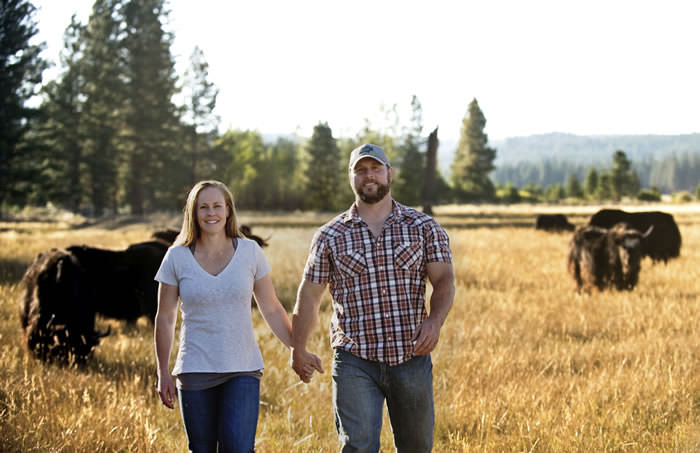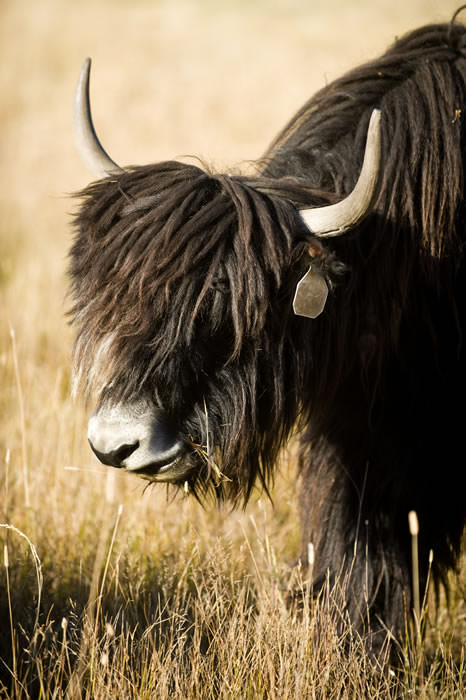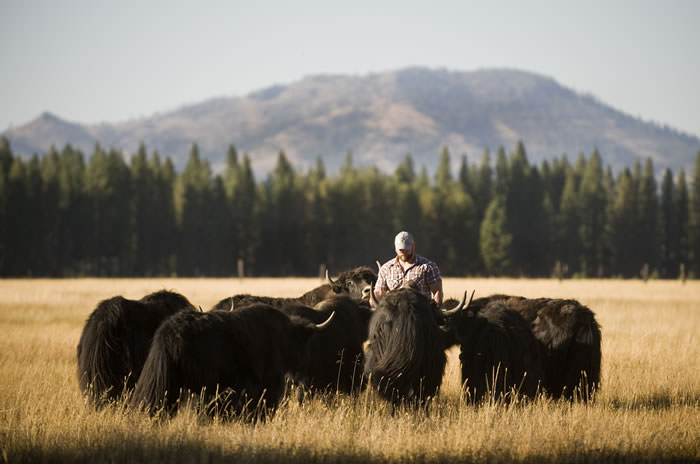meet the rancher
A KNACK FOR YAKS
Sierra Valley ranchers raise an ancient, distinctive breed.
WRITTEN BY CHRISTINA NELLEMANN
PHOTOS BY CANDICE NYANDO
With their charming faces, luscious hairstyles crowned by sharp horns, and energetic prancing, there is something quite elegant about yaks. Still, many people driving on Highway 89 near the town of Calpine, Calif., stop in the middle of the road to find out what strange creatures are roaming the lush meadows of Sierra Valley.
“They have this prehistoric beauty,” says Greg Gatto, owner of Sierra Valley Yaks. “It’s so cool to just watch them. There’s certainly an aura about them.”
“They’re smart, friendly, fierce, protective, and fun,” adds Jenna Endres, Gatto’s wife and business partner. “They have unique personalities. I’ve become a total fan.”

The grunting ox
Located on 80 acres, Sierra Valley Yaks currently tends a herd of 20 yaks. The herd is quickly expanding; about 10 of the females are pregnant. With names such as Amelia Earhart, Princess, Tammy Faye Baker, and Bieber (for her distinctive hairdo), the female yaks share their meadow with a bull and several other males that will be sold for meat.
“They are a sustainable and very versatile animal,” says Gatto, who has more than 17 years of ranching experience. “They produce a healthy meat with more protein than beef and have the dual purpose of meat and fiber.”
Yaks use about one-third the land and feed of beef cattle, and with their slower metabolisms in the winter, they are well adapted to our area’s high altitude and extreme weather. Raised on the Tibetan Plateau, and in Mongolia and Russia, these robust bovids have supplied meat, fiber, transport, and financial stability to the people of Central Asia for thousands of years. Their rich milk is even made into a butter tea. Because of their low burping sounds, yaks have been named the grunting ox.
Domesticated yaks are a single breed distinguished by their coloring. Native black yaks are pure black with gray noses; imperials are totally black; trims are black with touches of white on their long tails, foreheads, or feet; royals are a mix of white and black or white and gold; and the rare golden yaks have the coveted, honey-colored fur.

Exotic taste
Yaks mature more slowly than cattle, and males are not ready for butchering for about three years. Males typically weigh about 1,200 pounds; females weigh about 700 pounds and give birth to 35-pound calves. While the meat yields are not huge, the taste is light, crisp, and, with Sierra Valley Yaks’ grass-fed herd, available locally.
“The steak is really what sold us on yaks,” Gatto says.
The couple plans to sell the meat on their website, and several restaurant owners in the area are interested in adding it to their menus. One includes Truckee Tavern and Grill, which specializes in wood-fired meats. Also, the restaurant’s owners — Chris St. Martin and Ryan Dierks —emphasize fresh, locally raised, and hormone-free meats such as bison tri-tip, so yak is a good fit. In addition, the owners of The Fork & Horn in Sierraville also are interested in adding the meat to the menu. The restaurant is owned by Cassandra and Riz Martinetti — whose family has lived in the valley for nearly 100 years — and serves quality, local meats, including deer steak.
Endres has become the yak fiber expert in the family. While yaks require more maintenance on their hooves and coats than cattle, their undercoats yield a soft, warm fiber similar to cashmere. As a member of the Feather River Fibershed, Sierra Valley Yaks sells the washed fiber to shop owners and artisans in Northern California and Oregon. Its first customer happened to be the owner of Forgotten Coast Fly Co. in Apalachicola, Fla.; he wanted the yak hair for custom fly-fishing lures.
Similar to humans, a female yak gives birth to a single calf after nine months. When those baby yaks come along, there will be even more wooly wonders to see in the Sierra Valley.
“The babies are really cute,” Gatto says. “They look a bit like Ewoks.”
Christina Nellemann happily spent a summer morning with Greg and Jenna feeding their Sierra Valley yaks. She is partial to royal yak Princess, which nearly followed her back to her car.
Himalayan Pink Salt Yak Steaks
Endres recommends, as with most high-quality meats, minimal seasonings to enhance and not mask the flavor of the meat.
“For yak steaks, we like to grind up some Himalayan pink salt (great for a real, authentic yak experience) and sprinkle with pepper. We recommend salting about an hour in advance to allow the salt to penetrate the meat and act as a dry brine.
“We prefer a one-inch-cut steak, which allows us to reverse-sear the steak, increasing the tenderness without drying it out.
“We cook the steak on indirect heat at about 225 degrees F until the internal temperature is around 110 to 115 degrees F. At that point, we move the steak to a direct heat source, as hot as we can get it, and brown the exterior to allow for caramelization and the Maillard reaction.”
Recipe
Yak Meatloaf with Steak Fries and Arugula Salad
(courtesy of Greg Gatto and Jenna Endres, owners, Sierra Valley Yaks in Calpine, Calif. Serves 4, or 2 generously)
1 pound ground yak
1 shallot, minced
3 cloves garlic, minced
2 tablespoons fresh thyme, chopped
3 tablespoons olive oil
1 teaspoon kosher salt
¼ teaspoon pepper
1 tablespoon salted butter
½ cup panko breadcrumbs
2 tablespoons flour
2 tablespoons ketchup
4 tablespoons beef bouillon concentrate
2 medium-sized russet potatoes (or 1 extra-large potato)
1 bag arugula
1 tablespoon balsamic vinegar
1 tablespoon mayonnaise
For meatloaf
Place ground yak in medium-sized bowl. Add panko breadcrumbs, 1 tablespoon thyme, all the minced garlic, half the minced shallot, kosher salt, and pepper to bowl. Combine with your hands and form into loaf. Place meatloaf on roasting sheet and brush with ketchup. Roast meatloaf 15 to 18 minutes at 450 degrees F.
For gravy
Melt 1 tablespoon butter in medium pan over medium heat. Sauté remaining half of shallot and 1 tablespoon thyme until softened. Whisk flour, beef bouillon concentrate, and ¾ cup water into pan and let simmer until it thickens.
For steak fries
Slice potatoes into long, thin sticks, and toss with 1 tablespoon olive oil on roasting sheet. Season with salt and pepper. Roast 25 minutes at 450 degrees F until slightly browned. Flip halfway through roasting.
Arugula salad
In small bowl, mix balsamic vinegar, mayonnaise, and remaining 2 tablespoons olive oil. Salt and pepper to taste. Dress over arugula salad.


